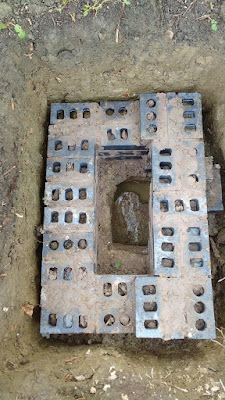Back to Stanton again to continue building the chamber walls in the 2 excavations on the down side cutting crest. These new chambers will provide access for ongoing maintenance of the crest drain and divert the flow from a land drain into the cess and stop the pooling next to the track.
 |
| Michael and Roger set up camp for the day |
 |
| Start point on excavation 1 |
 |
| Start point on excavation 2 |
Once the first mortar mix was ready Roger and Michael got started on the bricks. As there wasn't much else to do for a while, Stuart and Alastair went up to the Aqueduct to check on the down side slope of the cutting following the heavy rain over the last couple of days.
 |
| Michael starts on the back wall |
 | ||
Aqueduct Inlet
|
The inlet grille on the aqueduct box section had partly blocked with vegetation washed down the stream, this had raised the level so that water was flowing back out of the channel into the northbound crest. Not really what we want to happen.
 |
| Picture: Alastair |
 |
| Water level reduced |
Meanwhile back at the work face progress had been made.
 |
| Chamber 2 Crest/land drain |
 |
| Chamber 1 Crest/Cess |
The next diversion task was to replace a cracked lid on the up side cess where ballast had been tipped for loading into the Dogfish hoppers. The crack was so bad that the lid could have failed if somebody had stood on it.
 |
| Left hand lid cracked |
When the railway drainage was installed over 100 years ago the GWR seemed to follow a set pattern, in cuttings like at Stanton the cess drains had catchpits (chambers) every 30 yards on both the up and down sides. Since then maintenance work by the GWR and British Rail has introduced some anomalies, this and the lack of reliable drawings makes for a lot of investigatory work. For example, 2 cess drains run on each side from the aqueduct to Culvert 11A, a distance of 660 metres. In the middle of ballast tip site there should be chamber on the up side opposite one on the downside, as for the rest of the distance. But an exploratory dig on Monday and again today only unearthed what looks like drain blocks (hollow pre-cast concrete blocks that let the water pass through), no lids in sight.
 |
| Drain blocks 400 mm down under the ballast |
Rather than continue digging in both directions to try and locate the chamber, it was decided to abandon the search and try again by running the drain camera through the cess pipe. While we were in the area another wet patch was spotted on the down side cutting slope, more investigation ensued.
 |
| Looking for the source of the Nile (or the ground water) |
 |
| 5 minutes flow filled a hole in the cess |
 |
| Standing water on the down side at Culvert 11B |
STOP PRESS - Terminology page added with some of the basics explained. More will be added as and when time permits

I just noticed the Drainage Flickr site seems to have disappeared. Not a problem, particularly (especially with the Flickr changes), but I hope the images and captions were archived somewhere/how; there was a wealth of history there.
ReplyDeleteNoel
Hi Noel, I'm afraid Andy's Flickr site has been shut down, but we do have an archive of a great deal of the works. We are in the process of moving to centralised IT infrastructure so that important information can be securely managed. It's difficult to run an organisation our size while relying on volunteer's personal IT kit. Data acquisition and migration is proving a bit of headache
DeleteStuart
Stuart
ReplyDeleteA suggestion to improve the aqueduct's filter.
Increase the surface area of the filter 'mesh' by fabricating one shaped like a wedge, with a long sloping top/front, and triangular sides. It would then take longer for debris to block the larger surface area. You'd hope :o)
Eric
Eric
That's a good idea, we have these sloping grilles on the culvert at Bishop's Cleeve. This one is a drain cover that just happened to be handy. We can look at sloping it or one of the round bar half lids when time permits
DeleteThanks, Stuart
Stuart What sort of IT kit do you need, is it software or hardware?
ReplyDeletePowli Wilson
Hi Powli, Our Admin people are process of migrating all the departments to a centralised Sharepoint/Office 365 solution. Drainage migrated in January and we are nearly finished importing data. Before this volunteers ran departments on their own kit at home; since GDPR this had to be addressed hence the migration. It's allowing things to be regularised to a degree, corporate email and filestore are introducing better resilience, security and automated backup. All this has reduced the need to buy licences for home based applications so I don't think we need anything else at the moment.
DeleteThanks, Stuart
Thanks, The problem with I T is keeping abreast of the constant and continuing upgrades and enhancements; but if you/we don't we end up in even worse "****"!
ReplyDeleteHad a great day yesterday (Tuesday) admiring all the work your guys had done from the comfort of a maroon 2 + 1 open saloon!
Powli Wilson.